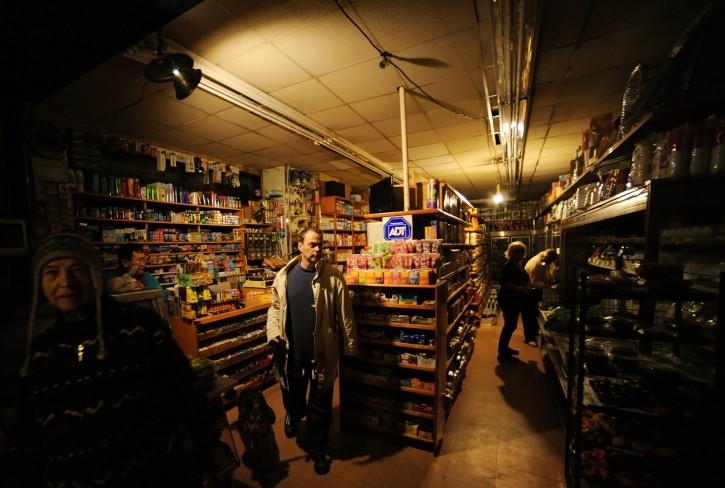 New York – The people gathered around the side of a building on Third Avenue looked like refugees huddled around a campfire. But instead of crackling flames, their warmth came from more advanced technology: a power strip that had been offered to charge cellphones.
New York – The people gathered around the side of a building on Third Avenue looked like refugees huddled around a campfire. But instead of crackling flames, their warmth came from more advanced technology: a power strip that had been offered to charge cellphones.
Subscribe to our Daily Roundup Email
It was a sign of just how desperate for electricity some New Yorkers have become since Superstorm Sandy darkened parts of the city.
Among the crowd was Patrick Dugan, who resorted to using a pay phone Wednesday as he trekked uptown from his powerless apartment, seeking electricity.
“How much does a pay phone cost?” asked Steve Breslawski, who had been watching his phone charge up for nearly an hour.
“It’s still 25 cents for local, 75 cents for long distance,” Dugan explained.
Most people scraped by with resilience and good humor in the storm’s aftermath, navigating a city without stoplights or subways. Many residents in dark downtown neighborhoods headed north to stay with friends. Others stayed home with canned goods and candlelight.
In an urban landscape of shuttered bodegas and boarded-up restaurants, they roamed in search of food, power and a hot shower.
The demarcation line of electricity was clearly drawn on certain streets, with buildings alight on one side and dark on the other. Life was remarkably normal uptown, albeit slower and quieter without public transportation. But downtown was a different matter entirely.
Street corners were chaotic below the general vicinity of 30th Street as people tried in vain to catch taxis. Without traffic lights or police officers to maintain some semblance of order, most intersections were treacherous for pedestrians.
As a fire hydrant spouted water on West 16th Street, 9-year-old Shiyin Ge and her brother, 12-year-old Shiyuan Ge, stood in line to fill up buckets of water. But unlike the adults, the two kids held plastic Halloween candy pails painted with grinning jack-o-lanterns.
“There’s no water in our house,” said Shiyin Ge, who had planned to dress up as a ladybug for Halloween. She did not know if she would get to trick-or-treat at all this year.
Rachel Booth sat outside of the Tribeca Treats bakery selling bags of colorful Halloween cookies, brownies and cake pops decorated to look like eyeballs. The bakery, still without lights, was also selling a few treats indoors.
“We wanted to bring a little bit of Halloween to people,” she said.
In ghostlike lower Manhattan, Nancy Yates picked up canned chicken noodle soup at a bodega that was lit by flashlight and candlelight on Wednesday morning. Although her building was mostly dark, the superintendent had set up power strips on every floor in single outlets linked to a generator.
“The freezer’s gone,” Yates said. “I’m worried about the coming days. I’m alone.”
Her neighbor, Norma Fontane, has been running an extension cord from the hall to her apartment to read by lamplight.
“We’ve all been in the building a long time,” she said. “We’re kind of looking out for one another.”
Nick Maenhout lives on West 37th Street, about six blocks above the blackout zone and can see the darkened section of Manhattan from his windows. He was stocking up on orange juice and chicken at a nearby supermarket to help feed friends who are crashing at his apartment.
“In case people come over and want something to eat, there’ll be something in the fridge,” he said.
At the Elliott-Chelsea Houses, a New York City Housing Authority complex, residents are without running water as well as power.
“Every day, I’m just going out looking for food and water,” said Magaly Perez, a single mother clutching the hand of her 5-year-old daughter, Jade.
Though many supermarkets and restaurants remained closed, New Yorkers were generous with the remaining food supply.
At the Church of the Holy Apostles on Ninth Avenue, volunteers set up tables on the sidewalk and handed out tuna sandwiches and apples. In front of Old Homestead Steakhouse on 14th Street, Greg Sherry set up tables and began grilling sirloin steak and lamb chops for $10 a pop.
“It’s going to be thrown out, so we figured we’d open up the doors and cook it up for the people in the community,” said Sherry. “Give back to the people of New York.” He served nearly 700 people.
Coffee was a precious commodity. Architect Peter Pelsinski joined the line of about a dozen people at a rust-colored cappuccino-and-espresso truck parked next to the gated Wall Street subway station. The smell was heavenly on the empty intersection as the sun shone brightly on the Hudson River.
“This is my first cup of coffee in a couple of days,” he said. “It will make my wife very happy.”
In Chelsea, Ann Kaplan was rolling a suitcase down the street on her way to a hotel where she had booked a room for three nights. Kaplan, an economist, has no power in her apartment – and she didn’t really mind leaving it behind for a while.
“They said if the power comes on before that, I can cancel,” she said. “But I kind of like the idea of a staycation.”

And fuel